So I went to build up a slant of wlp515 Antwerp ale yeast and there was a strong solvent/acetone aroma from the vial. The slant was about 12month and looking a bit dark. Checked my notes and I did notice an acetone smell in the jar the slants grew in. I made some beer from the yeast that inoculated the slants and it was clean, no acetone smell no phenolics.
Anyone ever experience this and what did you do?
First thought was to not use it but I figured I would see how it goes in a steps or two(only risking a little starter wort). Checked this morning and the first step(15mL) has yeast in suspension and got some foaming with a small swirl so it seems the slant did have some good cells. I did not pick up any acetone aroma.
So did some googling and solvent/acetone smell in beer seems to happen from stress or a possible contamination. As much as I would like to think it was a stress reaction sort of feel a contamination is more possible. Going to build ups the yeast a couple time to get enough to ferment a gallon of wort to see what happens.
If I do have acetobacter in the slant will it show signs in the starter or will I have to wait until after I make beer and there is alcohol?
Googling seems to show solvent/acetone to be a common thing with sour dough starters and results from stress/under feeding. I have experienced it myself with my sour dough starter when it sits for a while in the fridge without getting used. Always figured it was a bacteria thing not the yeast, but will a few feeding the starter would be back to normal.
Anyone ever experience this and what did you do?
First thought was to not use it but I figured I would see how it goes in a steps or two(only risking a little starter wort). Checked this morning and the first step(15mL) has yeast in suspension and got some foaming with a small swirl so it seems the slant did have some good cells. I did not pick up any acetone aroma.
So did some googling and solvent/acetone smell in beer seems to happen from stress or a possible contamination. As much as I would like to think it was a stress reaction sort of feel a contamination is more possible. Going to build ups the yeast a couple time to get enough to ferment a gallon of wort to see what happens.
If I do have acetobacter in the slant will it show signs in the starter or will I have to wait until after I make beer and there is alcohol?
Googling seems to show solvent/acetone to be a common thing with sour dough starters and results from stress/under feeding. I have experienced it myself with my sour dough starter when it sits for a while in the fridge without getting used. Always figured it was a bacteria thing not the yeast, but will a few feeding the starter would be back to normal.




